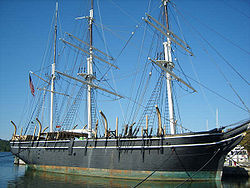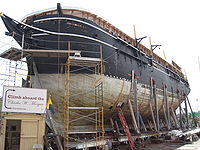Charles W. Morgan (ship)
| CHARLES W. MORGAN (Bark) | |
|---|---|
| U.S. National Register of Historic Places | |
| U.S. National Historic Landmark | |
|
The Charles W. Morgan moored at Mystic Seaport, CT.
| |
| Location: | Mystic, Connecticut |
| Coordinates: | 41°21′46.04″N 71°57′54.89″W / 41.3627889°N 71.9652472°WCoordinates: 41°21′46.04″N 71°57′54.89″W / 41.3627889°N 71.9652472°W |
| Built/Founded: | 1841 |
| Architect: | Hillman, Jethro & Zachariah |
| Architectural style(s): | Other |
| Governing body: | Private |
| Added to NRHP: | November 13, 1966[1] |
| Designated NHL: | November 13, 1966[2] |
| NRHP Reference#: | 66000804 |
Charles W. Morgan was a U.S. whaleship during the 19th and early 20th century. Ships of this type usually harvested the blubber of whales for whale oil, which was commonly used in lamps during the time period. The ship is currently an exhibit at the Mystic Seaport museum in Mystic, Connecticut.
History
The ship is named for its original owner, a Quaker whaling merchant who ordered its construction from the shipbuilders Jethro and Zachariah Hillman of New Bedford, Massachusetts. The ship's maiden voyage began on September 6, 1841, with a journey around Cape Horn and cruised across the Pacific Ocean. Following the Morgan's initial three year and four month voyage, she came home with 1,600 barrels of sperm oil, 800 barrels of whale oil and 10,000 lbs of whalebone, known as baleen, which was worth around USD$56,000.
The hull and deck of Morgan reflected the three typical functions of a whale ship:
- to serve as a mother ship to a fleet of small whaleboats, which are stored on the davits when not in use,
- to serve as a factory and a refinery ship with tryworks for extracting oil from the whale blubber,
- to serve as an oil tanker.
In her 80 years of service, she made 37 voyages ranging in length from nine months to five years. Charles W. Morgan, in total, brought home 54,483 barrels of sperm whale oil and 152,934 pounds of whalebone. She sailed in the Indian and South Atlantic Oceans, surviving ice and snow storms. Her crew survived a cannibal attack in the South Pacific. Between 1888 and 1904 she was based in San Francisco.
Morgan had more than 1,000 whalemen of all races and nationalities in her lifetime. Her crew included not only Americans, but sailors from Cape Verde, New Zealand, the Seychelles, Guadeloupe, and Norfolk Island. The ship's crew averaged around 33 men per voyage. As with other whaleships in the 1800s, Morgan often was home to the captain's family. The Morgan was owned and managed by the J. & W. R. Wing Company of New Bedford.[3]
During its years of service, Charles W. Morgan was used in several movies, including Miss Petticoats (1916), Java Head (1921) and Down to the Sea in Ships (1922).
On the night of June 30, 1924, the Charles W. Morgan caught fire when the flaming wreck of the steamer Sankaty, which had drifted across the Acushnet River from New Bedford harbor in flames, collided with it. Badly charred, Morgan narrowly escaped destruction.[4][5][6]
Retirement
The whaling days came to an end with the perfection of refining petroleum. Morgan was under the care of Whaling Enshrined, Inc. until 1941, when she was transferred to Mystic Seaport, where she still stands to this day. The ship is the only surviving wooden whaleship from the 1800s American fleet.[7]
Restoration
The Charles W. Morgan arrived at Mystic Seaport in December 1941, narrowly avoiding destruction during World War II. The ship was declared a National Historic Landmark and listed on the National Register of Historic Places in 1966.[2][7][8]
An initial restoration and preservation project was undertaken in 1968. A new restoration effort was started in 2009.
Mystic Seaport has recently completed a multi-million dollar shipyard upgrade to accommodate the next phase of Morgan's restoration, which is currently underway.
In 1971, the United States Postal Service issued a commemorative stamp honoring the Charles W. Morgan.
See also
References
- ↑ "National Register Information System". National Register of Historic Places. National Park Service. 2007-01-23. http://www.nr.nps.gov/.
- ↑ 2.0 2.1 "CHARLES W. MORGAN (Bark)". National Historic Landmark summary listing. National Park Service. http://tps.cr.nps.gov/nhl/detail.cfm?ResourceId=613&ResourceType=Structure. Retrieved 2007-10-03.
- ↑ "Successful whaler returns.". The New York Times. 1900-10-30
- ↑ The Dukes County Intelligencer. Vol. 24, No. 4. May 1983
- ↑ The American Neptune, 1941. Peabody & Essex Museum, Peabody Museum of Salem [1]
- ↑ Pacific Steam Navigation Company, Sea Breezes Vol. 56, no. 443 (Nov. 1982)[2]
- ↑ 7.0 7.1 "National Register of Historic Places Inventory-Nomination". National Park Service. 1974-12-11. http://pdfhost.focus.nps.gov/docs/NHLS/Text/66000804.pdf.
- ↑ "National Register of Historic Places Inventory-Nomination". National Park Service. 1974-12-11. http://pdfhost.focus.nps.gov/docs/NHLS/Photos/66000804.pdf.
External links
| ||||||||||
- Pages using duplicate arguments in template calls
- Pages with broken file links
- Whaling ships
- Museum ships in Mystic, Connecticut
- National Historic Landmarks in Connecticut
- Visitor attractions in New London County, Connecticut
- Tall ships of the United States
- Ships on the National Register of Historic Places
- Mystic, Connecticut
- Ships built in New Bedford, Massachusetts
- Individual sailing vessels
- National Register of Historic Places in Connecticut


